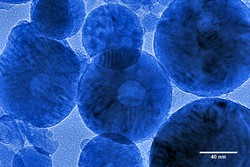Self-assembly of functional nanomaterials
An important but often overlooked design criterion for the production of supramolecular nanostructures (SN) is the combination of attractive and repulsive forces. EU provided financial support for the SUPRABIOMAT (Supramolecular biomedical materials) project, which combined principles of self-assembly and self-organisation for the fabrication of complex supramolecular systems. Researchers established a set of parameters for the design of supramolecular colloidal particles. The strategy of frustrated growth aimed to balance positive non-covalent interactions with repulsive forces. The specific unique feature of these SNs is that following the desired targeting event, the self-assembled scaffolds could be disassembled into small building blocks. This would reduce the residence time of the targeted agent, an aspect which had severely limited the application of non-reversible nanoparticulate imaging in biomedicine. Scientists reported the self-assembly of neutral amphiphilic dendritic nonaphenylalanines into the SNs in water. Circular dichroism spectroscopy of the polymerisation mechanism revealed that the process is non-cooperative with a remarkably high nanomolar binding affinity of the monomers. Both these properties contribute significantly to the stability of supramolecular nanorods; such high stability being typically observed for cooperative 1D polymerisation. Reported findings strongly support the idea that the self-assembly of the polyanionic dendritic peptide at neutral pH is directed by a mechanism of frustrated growth. The attractive supramolecular interactions (hydrogen bonding, interactions, and hydrophobic effects) drive the monomers to assemble, while opposed by repulsive electrostatic interactions that resist polymerisation. Researchers created a small library of charge-neutral dendritic peptide amphiphiles with a branched nonaphenylalanine-based core that was conjugated to hydrophilic dendrons of variable steric demand. They found that when the size of the hydrophilic dendron becomes too large, it limits 1D growth, producing objects that are restricted in size and globular in shape. In conclusion, aqueous self-assembly of anisotropic particles shows great promise for the development of functional supramolecular biomaterials for biomedical applications. The new evidence suggests that anisotropic shapes in carrier design outperform conventional isotropic materials for targeted imaging and therapy.







